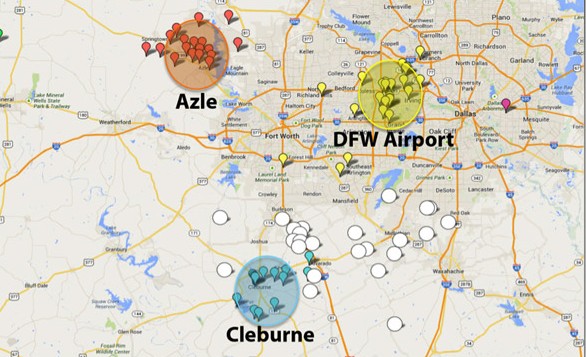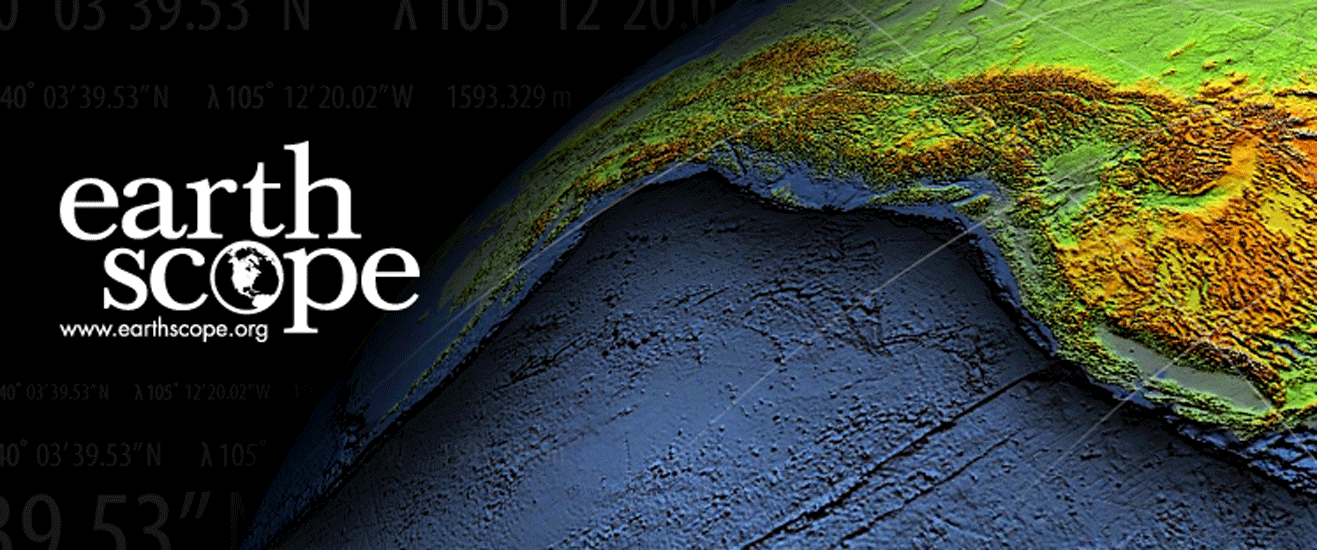North Texas Earthquake Study Group, Southern Methodist University - Spring 2014
There is currently public, scientific, and policy concern regarding the recent increased seismicity rates in the Central and Eastern US (CEUS). Whether due to tectonic or human-induced mechanisms, characterization of the seismic sequences is important for understanding seismic hazards within the stable continent. Examples of recent tectonic and potentially human-induced mid-magnitude CEUS activity include the 2011 Arkansas Earthquake Swarm culminating in a 4.7 event on 27 February, the 5.8 Virginia Earthquake on 23 August, the 5.6 Oklahoma Earthquake on 5 November, the 4.8 Southern Texas Earthquake on 20 October, and the 4.0 Ohio Earthquake on 31 December. A combination of USArray deployments (called the CEUSN permanent station adoption) and temporary local network deployments are providing local and regional observations that result in improved locations and source information. Temporary aftershock-like deployments in these areas use a combination of long-term broadband systems and short-term high-frequency studies to provide information for detailed source studies. The foundation of such local studies is the estimate of background seismicity that is being developed from the improvements in regional coverage provided by USArray.
The possibility that recent fluid-injection into deep wells has resulted in human-induced earthquakes further motivates a detailed study of CEUS seismicity associated with these types of activities, especially in light of published linkages to recent events in Texas, Arkansas and Ohio. The National Research Council Report, Induced Seismicity Potential in Energy Technologies (Shemeta et al, 2012) provides a comprehensive examination of the range of human activities that have been linked to man-induced seismicity including oil/gas extraction, secondary recovery, waste water injection, geothermal and hydraulic fracturing. As noted in this report, the number of possible cases of linked seismicity are relatively small, “Although only a small fraction of injection and extraction activities at hundreds of thousand of energy development sites in the United States have induced seismicity at levels that are noticeable to the public, seismic events caused by or likely related to energy development have been measured and felt in Alabama, Arkansas, California, Colorado, Illinois, Louisiana, Mississippi, Nebraska, Nevada, New Mexico, Ohio, Oklahoma and Texas.”
In the CEUS, regional seismicity increased from an average of 20 magnitude 3.0 and above events per year from 1970 to 2000 to more than 450 earthquakes from 2010 through 2013 (Ellsworth, 2012). This increase in seismicity raises questions about the underlying causes of the events, the methods of measuring seismicity, and the approaches to reducing risks associated with the induced events. One motivation for the CEUSN permanent station adoption has been to provide an enhanced set of seismic stations for quantifying both earthquake locations and wave propagation effects in the eastern US. The virtual network code _CEUSN has been prepared to facilitate access to this data set.

Above: Earthquakes between magnitude 2.1 and 3.7 reported by the National Earthquake Information Center in and around the Fort Worth Basin since 2008. Events in the three-labeled areas have each been found to occur on shallow faults with dimensions of a kilometer of two when supplemental data from RAMP like deployments are incorporated.
The Fort Worth Basin provides an example of increased seismicity in a region of active gas production and accompanying waste water disposal. Prior to 2008, there is no reported seismicity in the region. Since then, the USGS has reported 81 events between magnitude 2.1 and 3.7, many of them felt, producing a public concern. Two studies focused on the 2008-2009 sequence of earthquakes around the DFW Airport (Frohlich et al., 2011) and the 2009-2010 sequence near Cleburne, Texas (Howe-Justinic et al., 2013). Both studies examined the temporal and spatial relationship between nearby injection wells and the earthquake sequences. For the DFW airport study, the fact that the injection well began operating shortly before the earthquakes began and that the earthquakes were close to the well, provided a plausible indication that injection was in some way related to the start of earthquakes. In the case of the Cleburne sequence, although injection wells were located within a few kilometers of the earthquakes, there was no strong timing relationship. However, because there were no reported earthquakes prior to injection, the study was not able to reject injection as a possible cause. This is a weaker conclusion than in the DFW study. These two studies relied on RAMP instrumentation provided by IRIS PASSCAL in order to make near-source measurements of earthquakes as small as magnitude 0.5 in order to provide refined locations for purposes of imaging small faults. Routine locations provided by the USGS based on permanent instruments have associated errors that make association of the events with buried faults difficult. The combined use of portable and permanent instrumentation as supported by EarthScope and PASSCAL provides a unique opportunity to assessing these unusual events.
Although models are currently under development, both of the Fort Worth Basin studies suffered from a lack of a physical explanation (a model) for how fluid injection at specific sites could have resulted in the earthquake evolution over the observation period. Neither study contained a detailed understanding of the fault geometry, subsurface geology, and subsurface stress regimes. Neither study investigated similar natural sequences or similar injection histories without associated earthquakes. Neither study was able to continue instrumentation beyond the short term RAMP time periods. Without this understanding, neither study was able to suggest the future probability of larger events needed to develop the hazard associated with this fault. Therefore, seismologists are limited to using relatively crude statistical methods based on the observation history in similar tectonic regions in the U.S.
Increased public awareness and concern about seismicity in regions with little or no historical experience has most recently been illustrated with a third earthquake sequence of 27 NEIC events in the Fort Worth Basin near Azle, Texas. Although the earthquakes have been small with the largest M 3.6, there have been many felt events and concerns by local residents. The detailed assessment of these events that began in November 2013 has been possible with the deployment of portable equipment supplied by the USGS and PASSCAL among others. Real-time data telemetry has enhanced the study, providing the opportunity to adapt the configuration of the network to maximize the collection of high quality seismic data. Detailed subsurface information may provide an opportunity to move closer to a physical understanding of these events and their relationship to both production and disposal activities in the region. Public concern in this particular instance has reinforced the need for education and outreach activities in order to provide some basis for local communities to assess the earthquakes and their associated hazard.
Increased seismicity has been associated with areas where there has been increased development of unconventional tight shale gas and oil reservoirs (Shemeta et al., 2012). Technologies associated with horizontal drilling and hydraulic fracturing have made this resource recovery economically advantageous. Felt seismic events associated with these activities, including wastewater injection, are rare. Water is typically recovered with the gas that must be either disposed of or recycled. In 2011, there were eight case studies linking earthquakes to these waste water wells in the US out of roughly 30,000 US waste water injection wells (Shemeta et al, 2012). The vast majority of injection wells have no nearby detected earthquakes. The question is why? Understanding why a particular injector is associated with earthquakes while another similar well in similar conditions has no earthquakes remains a critical question whose answer lies in a multidisciplinary approach encompassing seismic monitoring, imaging, and an comprehensive understanding of local material properties and fluid flow.





